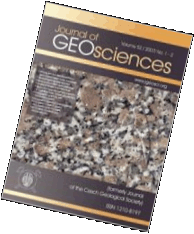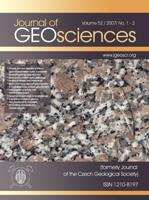 Export to Mendeley
Export to MendeleyOriginal paper
Origin of the pegmatite veins within the skarn body at Vevčice near Znojmo (Gföhl Unit, Moldanubian Zone)
Journal of Geosciences, volume 62 (2017), issue 1, 1 - 23
DOI: http://doi.org/10.3190/jgeosci.234
The lower crustal Gföhl Unit (Moldanubian Zone of the Bohemian Massif) consists of various felsic orthogneisses to migmatites (the so-called Gföhl gneiss) that are commonly associated with the high-pressure felsic granulites, serpentinized garnet/spinel peridotites, garnet pyroxenites, eclogites and skarns. The relatively small skarn bodies at Vevčice in southern Moravia have the prevailing assemblage of medium- to coarse-grained granoblastic clinopyroxene + garnet ± amphibole ± epidote. The skarn is cut by narrow veins of diorite pegmatite (SiO2 = 46-56 wt. %) which is geochemically distinct from granitic melt generated by migmatization of surrounding orthogneisses. Major pegmatite minerals are plagioclase (An18-44), amphibole (K-rich hastingsite and potassic-hastingsite) and quartz, accompanied by minor K-feldspar, garnet, allanite-epidote, clinopyroxene, and accessory titanite. The pegmatites are characterized by high contents of Fe2O3tot (11.2-17.5 wt. %), CaO (7.5-10.1 wt. %), Na2O (2.9-3.3 wt. %) and low contents of MgO (1.4-1.6 wt. %), K2O (1.2-1.6 wt. %), Rb (43-86 ppm). Whole-rock and mineral chemistry of diorite pegmatites are consistent with their origin as a product of melt infiltration from surrounding migmatites and subsequent contamination by the country-rock skarn, with or without, fractional crystallization/crystal accumulation. Similarity in composition of amphiboles in the skarn and in the pegmatite can indicate formation under similar conditions, at c. 750 °C and 0.7-0.8 GPa.
Webdesign inspired by aTeo. Hosted at the server of the Institute of Petrology and Structural Geology, Charles University, Prague.
ISSN: 1803-1943 (online), 1802-6222 (print)
email: jgeosci(at)jgeosci.org


IF (WoS, 2022): 1.4
5 YEAR IF (WoS, 2022): 1.8
Policy: Open Access
ISSN: 1802-6222
E-ISSN: 1803-1943